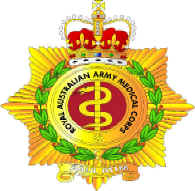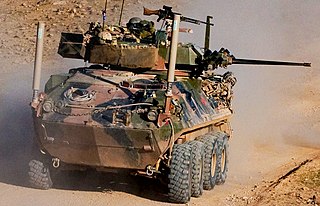
The Australian Army is the principal land warfare force of Australia, a part of the Australian Defence Force (ADF) along with the Royal Australian Navy and the Royal Australian Air Force. The Army is commanded by the Chief of Army (CA), who is subordinate to the Chief of the Defence Force (CDF) who commands the ADF. The CA is also directly responsible to the Minister for Defence, with the Department of Defence administering the ADF and the Army.

The Papua New Guinea Defence Force (PNGDF) is the military organisation responsible for the defence of Papua New Guinea. It originated from the Australian Army land forces of the territory of Papua New Guinea before independence, coming into being in January 1973 and having its antecedents in the Pacific Islands Regiment. The PNGDF is a small force, numbering around 3,600 personnel, and consists of a Land Element, an Air Element and a Maritime Element. It is a joint force tasked with defending Papua New Guinea and its territories against external attack, as well as having secondary functions including national-building and internal security tasks.

The Australian Defence Force (ADF) is the military organisation responsible for the defence of the Commonwealth of Australia and its national interests. It has three branches: the Royal Australian Navy (RAN), Australian Army and the Royal Australian Air Force (RAAF). The ADF has a strength of just over 89,000 personnel and is supported by the Department of Defence and several other civilian agencies.

The Special Air Service Regiment, officially abbreviated SASR though commonly known as the SAS, is a special forces unit of the Australian Army. Formed in 1957 as a company, it was modelled on the British SAS with which it shares the motto, "Who Dares Wins". Expanded to a regiment in August 1964, it is based at Campbell Barracks, in Swanbourne, a suburb of Perth, Western Australia, and is a direct command unit of the Special Operations Command.

The M113 is a fully tracked armored personnel carrier (APC) that was developed and produced by the FMC Corporation. The M113 was sent to United States Army Europe in 1961 to replace the mechanized infantry's M59 APCs. The M113 was first used in combat in April 1962 after the United States provided the South Vietnamese army (ARVN) with heavy weaponry such as the M113, under the Military Assistance Command, Vietnam (MACV) program. Eventually, the M113 was the most widely used armored vehicle of the U.S. Army in the Vietnam War and was used to break through heavy thickets in the midst of the jungle to attack and overrun enemy positions. It was largely known as an "APC" or an "ACAV" by the allied forces.

The Australian Army Reserve is a collective name given to the reserve units of the Australian Army. Since the Federation of Australia in 1901, the reserve military force has been known by many names, including the Citizens Forces, the Citizen Military Forces, the Militia and, unofficially, the Australian Military Forces. In 1980, however, the current name—Australian Army Reserve—was officially adopted, and it now consists of a number of components based around the level of commitment and training obligation that its members are required to meet.

The Royal Australian Army Medical Corps (RAAMC) is the branch of the Australian Army responsible for providing medical care to Army personnel. The AAMC was formed in 1902 through the amalgamation of medical units of the various Australian colonies and was first deployed to South Africa as a small detachment of personnel supporting the Australian Commonwealth Horse during the Second Boer War. The corps has participated in every Australian Army operation since then, including wars and peacekeeping operations. The "Royal" prefix was granted in 1948.

Disruptive Pattern Camouflage Uniform (DPCU), also nicknamed Auscam, jelly bean camo, or hearts and bunnies is a five-colour military camouflage pattern used by the Australian Defence Force. Replacing the jungle greens used from WWII, it was developed and tested during the late 1970s and early 1980s. The uniform was trialled in 1987, with it being slowly introduced in late 1989, with the last production and discontinuation of the jungle greens being in late 1990. Jungle greens were last issued in late 1991 for Australian Regular Army, and late 1994 for Australian Army Reserve.
FCU – UNTAC, the Force Communications Unit UNTAC, was the Australian component of the UNTAC mission in Cambodia.

Table Tops was a free daily newspaper produced for Australian Army personnel, published in the Atherton Tableland Training Area in Queensland, Australia, with regional editions produced abroad for serving personnel.

The 2nd Commando Regiment is a special forces unit of the Australian Army and is part of Special Operations Command. The regiment was established on 19 June 2009 when the 4th Battalion RAR (Commando) was renamed. It is based at Holsworthy, New South Wales. The 2nd Commando Regiment trains and has served with coalition special forces units, and is highly regarded by these units. The regiment has been involved in operations in East Timor, Iraq and Afghanistan, where it was used in a direct action warfighting role. It has also been involved in domestic security operations including the 2006 Commonwealth Games and the 2014 G20 Leaders Summit. The regiment is the Command's capability lead for strike and recovery.
Forces Command (FORCOMD) is the largest command within the Australian Army responsible for the combat brigades, the enabling and training formations reporting to the Chief of the Army with approximately 85% of the Army's personnel. The Command was formed on 1 July 2009 with the amalgamation of Land Command and Training Command, and is led by a major general as the Commander Forces Command.
The Army Logistic Training Centre (ALTC) is an Australian Army training establishment that is part of Forces Command. Established on 1 December 1995, through the amalgamation of nine separate logistic, health and personnel services schools and the Army College of TAFE, ALTC is headquartered at Bandiana, Victoria, and was established in response to the need to provide more effective logistic training, which had been identified as a problem as early as 1981. ALTC's motto is "Excel with Honour".

Operation Okra is the Australian Defence Force (ADF) contribution to the military intervention against the Islamic State. The force is part of Joint Task Force 633 in the Middle East. The operation commenced on 31 August 2014, and its initial stated aim was to combat ISIL threats in Iraq. In September 2015, the Australian airstrikes were extended to Syria. In June 2017, flights in Syria were temporarily halted in response to American forces shooting down a Syrian Air Force jet, before later being resumed.

The Australian Multicam Camouflage Uniform (AMCU) is the combat uniform camouflage pattern for the Australian Defence Force, general issued from 2014 onwards. The AMCU is replacing the previously used Disruptive Pattern Camouflage Uniform (DPCU) and Australian Multicam Pattern - Operational Combat Uniform (AMP-OCU) camouflage patterns.
The 1st Intelligence Battalion is an Australian Army unit responsible for collecting and analysing intelligence. It was formed in 1999, and is currently part of the 6th Brigade.

The Special Operations Logistic Squadron (SOLS) is an independent and specialised unit of the Australian Army based in Sydney which provides specialist logistical support to all units of the Special Operations Command in support of special operations. It has developed a "jack of all trades" capability across military logistics including rapid prototyping and metal fabrication.

The Australian Defence Force School of Special Operations is an Australian Army training unit part of the Defence Special Operations Training and Education Centre (DSOTEC) responsible for the recruitment, selection, training, education and trade management of all Special Operations Command (SOCOMD) personnel. It is based at Holsworthy Barracks, New South Wales. The school was established on 19 November 2019 following the renaming of the newly formed Special Operations Training and Education Centre.

Project Waler was an unsuccessful Australian defence procurement project which sought to replace the Australian Army's M113 armoured personnel carriers with more capable armoured fighting vehicles (AFVs). It was initiated in 1980 and cancelled in 1985 without any vehicles being procured.
The Army Aviation Command is the aviation command within the Australian Army responsible for the management and coordination of all army aircraft, as well as the development of future army aviation technology.















